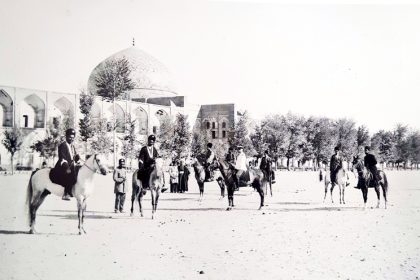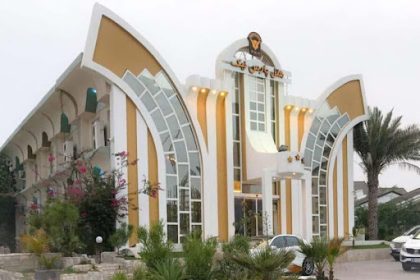Next to the dreamy beach, Valencia, this beautiful Mediterranean port, according to the locals, is a piece of heaven on earth. Under the warm rays of the southern sun, the beautiful historic churches are nestled in the streets lined with palm trees. Valencia is the city of sweet oranges, Spanish paella, spectacular museums, colorful festivals and football.
As the old capital of the Kingdom of Valencia, Spain‘s third largest city is rich in cultural heritage. Magnificent historical monuments, including the 15th-century Silk Market, the 18th-century Marquis Palace, and the Museum of Fine Arts tell the story of a city of wealthy merchants and aristocrats.
However, Valencia hastily entered the 21st century and tradition and modernity are mixed in this city. In this article from Alibaba, join me to introduce you to the places of interest in Valencia.
1. Valencia City of Arts and Sciences (Ciudad de las Artes y las Ciencias)

A large cultural complex with modern and beautiful architecture, which is located along the Turia River and its construction was completed in 2005. Valencia City of Arts and Sciences is one of the most popular places to visit in Valencia and Europe, dedicated to cultural and scientific exhibitions.
The special and complex architecture of this complex is so impressive that it attracts many architects and architecture enthusiasts from all over the world to Valencia, Spain every year.

The City of Arts and Sciences consists of 6 main parts: the Hemispheric IMAX cinema showing digital films, the Umbracle area with a great view, the Prencipe Felipe Science Museum, the Interactive Science Museum, the Oceanogràfic Aquarium, the Reina Sofía Opera House and Agora concert hall.
The City of Arts and Sciences hosts conferences, exhibitions and educational workshops on scientific and artistic topics.
Address: 5 Avenida Autopista del Saler, Valencia
2. Museum of Fine ArtsMuseo de Bellas Artes)

The Museum of Fine Arts of Valencia, also known as San Pio V, is a wonderful place to discover the artistic heritage of the Valencia region. Ancient findings, paintings and sculptures are displayed in this museum.
Most of the art collections focus on the works of Valencian artists, from the medieval period to the modern era. The works of Valencian artists of the 19th and 20th centuries are among these eye-catching works. One of the most important works of this museum is the 14th century altar of Boni Ferrer (Valencian monk) by the Florentine artist Gerardo Starnina.
The works of famous painters such as Diego Rodriguez de Silva, Bartolome Esteban Murillo, Joaquin Soria, El Greco, Francisco Goya and Luis de Morales are also kept in this museum.
Address: 9 San Pio V, Valencia
3. National Museum of CeramicsCeramics Museum)

The National Museum of Ceramics is the only national museum in Valencia and is located near the San Martin Cathedral. Most of the national museums are located in Madrid. This museum is located in the beautiful palace of “Marqués de dos Aguas”.
In this museum, more than 5000 examples of traditional pottery from Valencia and its surroundings, Toledo and Seville are exhibited. Ancient Greek, Roman and Arab pottery, fine porcelain from China and Japan, modern pieces by Mariano Benlivre and Picasso can also be seen in this fascinating museum.
If you go to the National Museum of Ceramics, you must see the outstanding work of this museum; Check out the fully equipped 19th century Valencian kitchen with beautiful traditional tiles.
Address: 2 Calle Poeta Querol, Valencia
4. Valencia Cathedral (Catedral de Valencia)

Valencia Cathedral is a magnificent church with Gothic architecture. The cathedral was built on the site of an old Moorish mosque in the 13th century and rebuilt in the 17th century.
The exterior of the church is a combination of the original Romanesque, Gothic and Baroque architectural elements. Polished azure tiles adorn the domes, a distinctive feature of Valencia’s skyline. Before entering, spend plenty of time admiring this beautiful view. The interior of the church, with its magnificent domed ceiling and tall windows that illuminate the space, is one of the most beautiful sights in Valencia.
The walls of the church are adorned with artistic masterpieces, including Goya paintings and crosses by Alonso Cano. The octagonal tower “Miguelete” is one of the other sights of Valencia that is located in this church. Climb the stairs of the tower and touch the city under your feet.
The church museum has a beautiful collection of paintings and many jewels and gold. The most famous piece of this museum is a cup known as “Santo Caliz” (Santo Caliz), which is said to be the famous holy cup (according to medieval legends, the cup from which Jesus drank at the last supper and later Yusuf Ermati collected Christ’s blood in it) ).
The cathedral is one of the most unforgettable sights in Valencia.
5. La Lonja La Lonja de la Seda

This magnificent Gothic structure was built in the 15th century with the use of the city’s silk market. A bazaar where the famous silk of Valencia was traded with merchants and sent all over Europe. La Lonja is one of the finest examples of Gothic architecture in Europe, with its small exterior congresses and large towers reminiscent of medieval palaces.
When you enter this 600-year-old building, you are faced with an orange garden, which gives a magnificent appearance to this building. Probably the silk merchants used to rest under the shade of these trees after a working day.
The main building of this building, known as the contract hall, is decorated with beautiful spiral columns. This hall was the financial center of La Lonja, where merchants signed contracts. The next hall was also called the Commercial Court, which was the first court in Spain for the crimes of merchants and traders. The walls of the commercial court are decorated with beautiful paintings and the doors and windows of this hall will undoubtedly attract the attention of every viewer.
If you climb the 144 stone steps of this building, your reward is a stunning view of the city of Valencia. Visiting this tourist attraction in Valencia is open to the public daily. On Sundays, a coin and stamp exhibition is held in Lalonkha.
Address: Plaza del Mercado, Valencia
6. Valencia Oceanographic Aquarium Oceanogràfic Valencia

The Oceanographic Aquarium of Valencia was built by the Spanish architect Félix Candela as part of the Valencia City of Arts and Sciences. The aquarium is actually a collection of several buildings, each dedicated to one of the most important marine ecosystems and environments on Earth: wetlands, oceans, Mediterranean, Antarctic, Arctic and islands, and the Red Sea.
45,000 fish and aquatic animals from 500 different species of marine animals are kept in this aquarium. Dolphins, sea turtles, beluga whales, sea lions, penguins, spider crabs, etc. are among the most popular marine animals in this aquarium.
One of the most exciting parts of this aquarium is the tunnel where you are surrounded on both sides by giant sharks. In addition to watching marine life, you can see mangrove swamps, fields, forest wetlands, and other wetland environments with native plant species in this complex. You can also enjoy delicious seafood at an underwater restaurant located among the giant aquariums after a tour of the Oceanographic Aquarium.
Address: Autopista del Saler 5, Valencia
Visiting hours: 10 am to 6 pm
7. Biopark Valencia Bioparc Valencia

One of the most attractive places to visit in Valencia is Bio Park. This 25-hectare zoo is one of the most important zoos in Spain. Biopark is mostly famous for its large collection of African animals.
There is no fence and cage in Biopark. Animals live freely in the open air. This environment is designed in such a way that the visitors feel that they have gone to the African nature. You see animals almost as freely as the nature of the savannah, Madagascar and tropical Africa. Instead of separating different species, they coexist with each other like in their native environment.
For example, in the Savannah, lions, giraffes, antelopes and rhinoceros all live together in the wild. Gorillas inhabit a dense tropical forest, while rhinos and crocodiles cool off in the water.
In order to maintain the safety of the visitors, Bio Park authorities have placed barriers between humans and wild animals such as lakes or paths at a higher altitude. But you can easily be in close contact with domestic animals.
Address: Avda. Pío Baroja, 3, Valencia
8. Serranos Towers (Gate of the Old City)Torres de Serranos)

Serranos Towers is one of the most important sights of Valencia and a symbol of this city. This building is the ancient gate of the old city and reminds of the time when Valencia was surrounded by defensive walls. Today, these medieval buildings no longer exist, but two gates still stand, one of which is the Serranos Towers.
The ramparts of this tower were built on top of Roman buildings in the 14th century. In 1930, the Serranos towers were restored and returned to their former glory. The view of the city of Valencia from the top of these towers is indescribable.
Tickets to visit the Serranos Towers are free for adults and children on Sundays.
Address: Plaza dels Furs, Valencia
Visiting hours: every day from 10-14 and 16:30 to 20:30 (closed on Mondays).
9. Fallas festival Las Fallas Festival

You might be surprised by the presence of Fallas Festival among the sights of Valencia. This is not a landmark of Valencia, a museum or a monument, but it is one of the most popular tourist attractions in Valencia, Spain.
Every year in March, Valencia hosts the “San Jose Festival” (Fallas Festival). This religious festival is famous for its creative image. These sculptures and icons are made with crumpled paper.
These effigies are erected in the streets and burned at midnight on the last day of the festival. This custom originates from the Middle Ages. When carpenters and other craftsmen burned the leftover scraps of wood and other materials on the feast of St. Joseph.
During the days of the festival, the streets of the city are full of excitement and joy. Fallas is a fusion of art, humor and patriotism of the people of Valencia. People from all over Spain and Europe go to Valencia to see this ceremony and prepare for the start of spring by burning things that don’t hurt.
If you plan your trip to Spain with this festival, be sure that you will not regret it.
10. Valencia del Mercado Palace Plaza del Mercado

Another must-see in Valencia is the Mercado Palace. This palace consists of three separate buildings, each of which has a different use. These buildings are beautifully placed together and attract many tourists to Spain and Valencia every year.
The buildings of this palace are called Lonja de la Seda, Santos Juanes and Mercado Central. I told you about Lonja de la Lonja a little earlier, but what are the other two buildings used for?
One of them is the beautiful and magnificent church of Santos Juanes, which was designed and built using the baroque architectural style. The large grocery store named Mercado Central is another building of this palace, which has a modern and very beautiful architecture.
The main view of Palacio del Mercado is the Lonja de la Building, and on the left side of this palace, you will see the Santos Juanes building, and right in front of it, you will see the Mercado Central department store with beautiful ceramic, iron and glass domes.
At Mercado Central, you can buy from chicken milk to human life! Go to the restaurants of this mall and try local Spanish cuisine. Also, this store is a good option for buying gifts and souvenirs.
Address: 46001 Valencia, Spain
last word
Thank you for being with me until this point in the article and we have reviewed the places of interest in Valencia together. With the knowledge you gained about the sights of Valencia, on your trip to this historic city, go to the sights of this city and enjoy your trip.
RCO NEWS

















